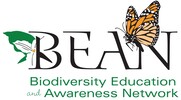|
The Ontario Biodiversity Council (OBC) was created in 2005, along with 3 working Groups.
|
The Biodiversity Education and Awareness Network (BEAN), was one of those working groups - set to achieve 3 key targets from the Ontario Biodiversity Strategy.
|
|
1. Employ strategies to effectively communicate the relevance of biodiversity to the public.
|
2. Continue to integrate biodiversity education into all levels and types of curricula.
|
